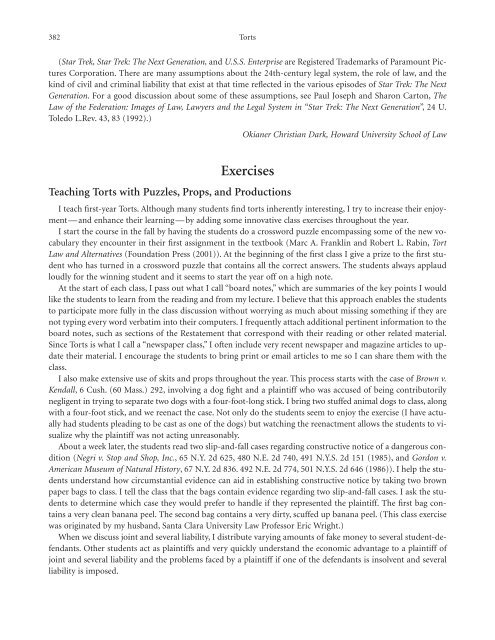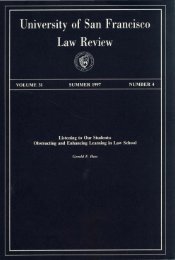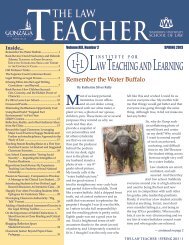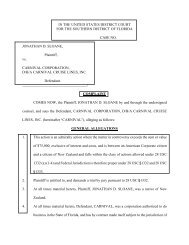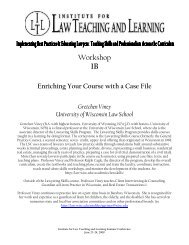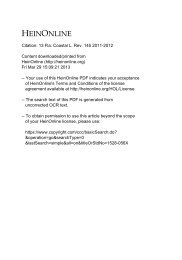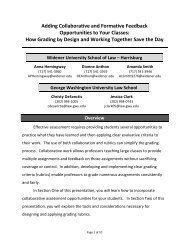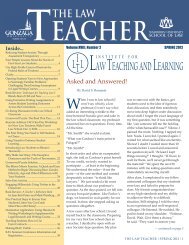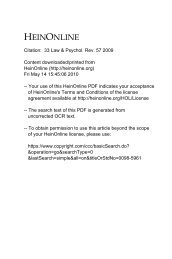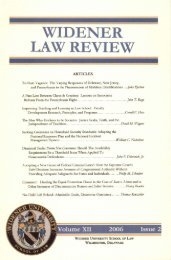Teaching the Law School Curriculum - Institute for Law Teaching ...
Teaching the Law School Curriculum - Institute for Law Teaching ...
Teaching the Law School Curriculum - Institute for Law Teaching ...
Create successful ePaper yourself
Turn your PDF publications into a flip-book with our unique Google optimized e-Paper software.
382 Torts<br />
(Star Trek, Star Trek: The Next Generation, and U.S.S. Enterprise are Registered Trademarks of Paramount Pictures<br />
Corporation. There are many assumptions about <strong>the</strong> 24th-century legal system, <strong>the</strong> role of law, and <strong>the</strong><br />
kind of civil and criminal liability that exist at that time reflected in <strong>the</strong> various episodes of Star Trek: The Next<br />
Generation. For a good discussion about some of <strong>the</strong>se assumptions, see Paul Joseph and Sharon Carton, The<br />
<strong>Law</strong> of <strong>the</strong> Federation: Images of <strong>Law</strong>, <strong>Law</strong>yers and <strong>the</strong> Legal System in “Star Trek: The Next Generation”, 24 U.<br />
Toledo L.Rev. 43, 83 (1992).)<br />
Okianer Christian Dark, Howard University <strong>School</strong> of <strong>Law</strong><br />
Exercises<br />
<strong>Teaching</strong> Torts with Puzzles, Props, and Productions<br />
I teach first-year Torts. Although many students find torts inherently interesting, I try to increase <strong>the</strong>ir enjoyment<br />
— and enhance <strong>the</strong>ir learning — by adding some innovative class exercises throughout <strong>the</strong> year.<br />
I start <strong>the</strong> course in <strong>the</strong> fall by having <strong>the</strong> students do a crossword puzzle encompassing some of <strong>the</strong> new vocabulary<br />
<strong>the</strong>y encounter in <strong>the</strong>ir first assignment in <strong>the</strong> textbook (Marc A. Franklin and Robert L. Rabin, Tort<br />
<strong>Law</strong> and Alternatives (Foundation Press (2001)). At <strong>the</strong> beginning of <strong>the</strong> first class I give a prize to <strong>the</strong> first student<br />
who has turned in a crossword puzzle that contains all <strong>the</strong> correct answers. The students always applaud<br />
loudly <strong>for</strong> <strong>the</strong> winning student and it seems to start <strong>the</strong> year off on a high note.<br />
At <strong>the</strong> start of each class, I pass out what I call “board notes,” which are summaries of <strong>the</strong> key points I would<br />
like <strong>the</strong> students to learn from <strong>the</strong> reading and from my lecture. I believe that this approach enables <strong>the</strong> students<br />
to participate more fully in <strong>the</strong> class discussion without worrying as much about missing something if <strong>the</strong>y are<br />
not typing every word verbatim into <strong>the</strong>ir computers. I frequently attach additional pertinent in<strong>for</strong>mation to <strong>the</strong><br />
board notes, such as sections of <strong>the</strong> Restatement that correspond with <strong>the</strong>ir reading or o<strong>the</strong>r related material.<br />
Since Torts is what I call a “newspaper class,” I often include very recent newspaper and magazine articles to update<br />
<strong>the</strong>ir material. I encourage <strong>the</strong> students to bring print or email articles to me so I can share <strong>the</strong>m with <strong>the</strong><br />
class.<br />
I also make extensive use of skits and props throughout <strong>the</strong> year. This process starts with <strong>the</strong> case of Brown v.<br />
Kendall, 6 Cush. (60 Mass.) 292, involving a dog fight and a plaintiff who was accused of being contributorily<br />
negligent in trying to separate two dogs with a four-foot-long stick. I bring two stuffed animal dogs to class, along<br />
with a four-foot stick, and we reenact <strong>the</strong> case. Not only do <strong>the</strong> students seem to enjoy <strong>the</strong> exercise (I have actually<br />
had students pleading to be cast as one of <strong>the</strong> dogs) but watching <strong>the</strong> reenactment allows <strong>the</strong> students to visualize<br />
why <strong>the</strong> plaintiff was not acting unreasonably.<br />
About a week later, <strong>the</strong> students read two slip-and-fall cases regarding constructive notice of a dangerous condition<br />
(Negri v. Stop and Shop, Inc., 65 N.Y. 2d 625, 480 N.E. 2d 740, 491 N.Y.S. 2d 151 (1985), and Gordon v.<br />
American Museum of Natural History, 67 N.Y. 2d 836. 492 N.E. 2d 774, 501 N.Y.S. 2d 646 (1986)). I help <strong>the</strong> students<br />
understand how circumstantial evidence can aid in establishing constructive notice by taking two brown<br />
paper bags to class. I tell <strong>the</strong> class that <strong>the</strong> bags contain evidence regarding two slip-and-fall cases. I ask <strong>the</strong> students<br />
to determine which case <strong>the</strong>y would prefer to handle if <strong>the</strong>y represented <strong>the</strong> plaintiff. The first bag contains<br />
a very clean banana peel. The second bag contains a very dirty, scuffed up banana peel. (This class exercise<br />
was originated by my husband, Santa Clara University <strong>Law</strong> Professor Eric Wright.)<br />
When we discuss joint and several liability, I distribute varying amounts of fake money to several student-defendants.<br />
O<strong>the</strong>r students act as plaintiffs and very quickly understand <strong>the</strong> economic advantage to a plaintiff of<br />
joint and several liability and <strong>the</strong> problems faced by a plaintiff if one of <strong>the</strong> defendants is insolvent and several<br />
liability is imposed.


